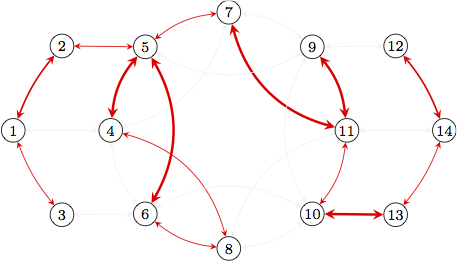Although networks cannot be claimed to be a recent invention it is safe to assert that the irruption of networks into everyday life is a determinant feature of the late 20th century. Technological networks have transformed the way in which we interact with each other and the way in which we acquire and manipulate information. At the same time, we have come to realize that underlying networks of influence and interaction play a fundamental role in explaining the behavior of large scale natural and social phenomena. Understanding networks has thus emerged as one of the great intellectual challenges of the 21st century. My research is about the application of Signal and Information Processing tools to the design of networks, the development of network algorithms, and the understanding of networked phenomena.
 Figure 2. Wireless networks. In wireless networks (middle and bottom) links are established by a resource allocation decision to spend power and bandwidth on a specific connection for a specific fading state. Links can be different at different times and have time varying capacities.
Figure 2. Wireless networks. In wireless networks (middle and bottom) links are established by a resource allocation decision to spend power and bandwidth on a specific connection for a specific fading state. Links can be different at different times and have time varying capacities.
For the most part my research is about the foundational understanding of these topics in what many have come to call the emerging field of Network Theory. There are myriad contexts in which networks play a fundamental role but a common thread that weaves them together is the local interaction versus global behavior dichotomy. In networked systems we only have knowledge and control on local actions but want to explain or enforce network-wide behavior. As a Network Theory researcher my expertise is in various tools that can be used to bridge this dichotomy. Besides this, my philosophy is to be agnostic with respect to tools and applications.
Agnosticism notwithstanding, the different projects that constitute my current research program accept a taxonomy that differentiates between situations in which the goal is to design algorithms suitable for implementation on networked infrastructures, analyze phenomena in which underlying network interactions explain a significant part of the observed behavior, or, design the network infrastructure itself:
- Network algorithms. Algorithms are the typical deliverable of research efforts in Signal and Information Processing. E.g., the solution of an estimation problem is an algorithm to compute good estimates for a given data set. In network algorithms the information to be processed is distributed throughout the network and the goal is to design mechanisms to process this information based on local interactions between neighboring nodes. In, e.g., distributed estimation problems, observations are acquired by different nodes and the estimation algorithm intends to accumulate global information through message exchanges that are restricted to neighboring nodes. I currently have three active research projects in this space, namely, "Bayesian Network Games," "Distributed Optimization," and "Wireless Control Systems."
- Networked data structures. A networked data structure is one in which there is some notion of locality. In the count of pairwise message exchanges between members of a group most messages sent by a given individual are concentrated on a few recipients, the level of expression of a gene affects the level of expression of just a few other genes, the output of an economic sector has significant direct effect on just a few other sectors, and so on. Conventional information processing algorithms that ignore this local structure can be applied. However, if the networked structure is ignored we should not expect to be able to understand what is the role the network plays in explaining observed behaviors. In this problem category our goal is to perform analysis of networked data structures that do not ignore the fact that the network is, indeed, a network. The two projects that belong in this category are "Hierarchical Clustering in Asymmetric Networks" and "Authorship Attribution using Word Adjacency Networks."
- Network infrastructure. While it has taken humanity a century to realize, our society's infrastructure is about connectivity. The transportation infrastructure connects places, the energy infrastructure connects generators with consumers, the communication infrastructure connects people, and the market infrastructure connects savers with developers. In network infrastructure design problems we are given resources that we administer to establish desirable connectivity patterns. My work on network infrastructure is on the design of wireless communication networks. In such case we are given resources in the form of power budgets and bandwidth that we allocate to establish direct communication links in order to support end-to-end communication flows. On top of deciding which connections should be established among those possible for the given bandwidth and power, we also want to determine suitable routes, link shares, and admission control variables to support the required level of service. I am currently working on "Optimal Design of Wireless Communication and Networking Systems" and the design of "Communication Networks for Autonomous Robot Teams."
A brief description of each of the different research projects described above can be accessed through the navigations menu on the left.A brief description of each of the different research projects described above can be accessed through the navigations menu on the left. If you are the type of person that prefers to read printed documents, the same material is available in my research overview document.
